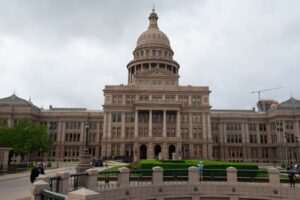By Piper Watson,
North Central Texas Academy
The story of Texas’s State Capitol started long ago when it was established in 1839. The second president of the Republic of Texas, Mirabeau Lamar, wanted to make the town of Waterloo the Capitol of Texas. After the Texas Congress had approved the spot, the name was changed to Austin to honor Stephen F. Austin.
As time went on, Austin began to change and grow. The Capitol building started as a log cabin that had two larger and two smaller meeting rooms with an eight-foot stockade fence that aided in protection from Indian raids. In 1853, the Capitol had been improved into a limestone building located at Capitol Square, the current spot of the Confederate Soldiers’ monument. It was nicknamed an “architectural monstrosity” due to its lack of architectural refinement. When the Constitution of 1876 was created, they authorized 3 million acres of public land in the Texas Panhandle to be used to pay to build a new Capitol. A group from Chicago paid to construct our present-day Capitol in exchange for all of the land that eventually became the famous XIT ranch.
In 1880, Texas officials announced a reward of $1,700, which is worth $49,861.67 now, to whomever won the nationwide competition with the best design for the new Capitol. Architect Elijah E. Myers made the design that was approved by Texas officials. Before the Capitol’s construction could begin, there was a fire that almost burned the plans on November 9, 1881. While the limestone Capitol was on fire, the Capitol Board had been in a meeting inside. Limestone from south Austin began being used to construct the foundation for the Capitol by contractors in 1881.
Sadly, they discovered that when exposed to the atmosphere, the limestone began to become discolored. They began looking for other options and found that Texas Sunset Red Granite would be the perfect building material. Then the owners of Granite Mountain in the nearby county of Burnet constructed a railroad especially for workers to transport the donated 188,518 cubic feet of the special granite that was needed. Numerous civic and government dignitaries attended the ceremony when the cornerstone was laid by Texans on March 2, 1885. Inside the 12,000-pound stone was a little zinc box inside a carved niche that held mementos that had been collected. Massive stones from railcars were hoisted up to any parts of the outside walls of the Capitol by ten derricks. When the Capitol building was completed it had 392 rooms, 404 doors, and 924 windows. In 1887, iron braces and wrought iron framework were imported from Belgium to make a dome that was then painted to match the Capitol’s granite.
The year 1888 had a lot of accomplishments for our Capitol. In February, the Goddess of Liberty was created by metal contractors by welding 80 zinc pieces into the torso, two arms, and head. Each section was hoisted to the top of the dome and put in place by large screws. In May, over 20,000 people attended a week of celebrations at the new Capitol. The festivities included fireworks, band concerts, drill team competitions, and military displays. There were special streetcar lines that would bring large groups of people from an encampment a mile outside of town into the city. Crowds filled the Capitol grounds and lined Congress Avenue to view the dedication to the Capitol. The youngest son of Sam Houston, Senator Temple Houston, accepted the building on behalf of the state while expressing the pride that Texans felt in the building. “This building fires the heart and excites reflections in the minds of all… the architecture of a civilization is its most enduring feature, and by this structure shall Texas transmit herself to posterity” (Temple Houston).
Today in 2023, the Capitol is an extremely popular tourist spot for those wanting to learn about our history, and just to tour or look around. Having the esteemed opportunity to visit here and look at all of the extraordinary architecture and detail is certainly something that should reside on your bucket list. There are numerous artifacts and information all over the halls. The Capitol building in Austin, Texas is a fascinating, historical sight to see.
In 1947, the YMCA of Texas organized the first Youth and Government Conference. 76 years later we have the option to all travel to meet at the government Capitol of Texas. Delegates that put in the hard work get the opportunity to visit our Capitol to get to debate bills in the Senate and House for Legislative, propose solutions to our biggest problems in State Affairs, and see the entire capitol to document and interview in media. We are blessed to be able to get come to our Capitol to be able to learn and show the valuable skills that Youth and Government has taught us.


